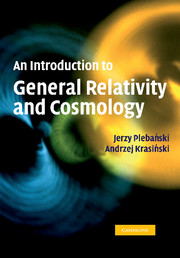Book contents
- Frontmatter
- Contents
- List of figures
- The scope of this text
- Acknowledgements
- 1 How the theory of relativity came into being (a brief historical sketch)
- Part I Elements of differential geometry
- Part II The theory of gravitation
- 12 The Einstein equations and the sources of a gravitational field
- 13 The Maxwell and Einstein–Maxwell equations and the Kaluza–Klein theory
- 14 Spherically symmetric gravitational fields of isolated objects
- 15 Relativistic hydrodynamics and thermodynamics
- 16 Relativistic cosmology I: general geometry
- 17 Relativistic cosmology II: the Robertson–Walker geometry
- 18 Relativistic cosmology III: the Lemaître–Tolman geometry
- 19 Relativistic cosmology IV: generalisations of L–T and related geometries
- 20 The Kerr solution
- 21 Subjects omitted from this book
- References
- Index
12 - The Einstein equations and the sources of a gravitational field
Published online by Cambridge University Press: 01 March 2010
- Frontmatter
- Contents
- List of figures
- The scope of this text
- Acknowledgements
- 1 How the theory of relativity came into being (a brief historical sketch)
- Part I Elements of differential geometry
- Part II The theory of gravitation
- 12 The Einstein equations and the sources of a gravitational field
- 13 The Maxwell and Einstein–Maxwell equations and the Kaluza–Klein theory
- 14 Spherically symmetric gravitational fields of isolated objects
- 15 Relativistic hydrodynamics and thermodynamics
- 16 Relativistic cosmology I: general geometry
- 17 Relativistic cosmology II: the Robertson–Walker geometry
- 18 Relativistic cosmology III: the Lemaître–Tolman geometry
- 19 Relativistic cosmology IV: generalisations of L–T and related geometries
- 20 The Kerr solution
- 21 Subjects omitted from this book
- References
- Index
Summary
Why Riemannian geometry?
As argued in Section 1.4, gravitational forces can be simulated by inertial forces in accelerated motion. Special relativity describes relations between objects in uniform motion with respect to inertial frames, while gravitational interactions are neglected. The metric of the Minkowski spacetime in an inertial reference frame has constant coefficients. If we transform that metric to an accelerated frame, its components will become functions. Hence, a gravitational field should have the same effect: in a gravitational field the metric should also have non-constant components. Unlike in the Minkowski spacetime, in a gravitational field it should not be possible to make the metric components constant by a coordinate transformation. This was, in great abbreviation, the basic observation that led Einstein (1916) to general relativity.
This idea had to be supplemented with equations that would generalise the Newtonian laws of gravitation, and would relate the metric form to the gravitational field. The derivation of these equations, together with several related matters, will be presented in this chapter.
Local inertial frames
Let us recall the conclusion of Chapter 1: the Universe is permeated by gravitational fields that cannot be screened. Their intensity can be decreased by going away from the sources, but one can never decrease that intensity below the minimum determined by the local mean density of matter in the Universe. For this reason, no body in the Universe moves freely in the sense of Newton's mechanics, and consequently inertial frames can be realised only approximately, with a limited precision. Moreover, there exists no natural standard of a straight line, so the departures of real motions from rectilinearity cannot be measured.
- Type
- Chapter
- Information
- An Introduction to General Relativity and Cosmology , pp. 125 - 160Publisher: Cambridge University PressPrint publication year: 2006



